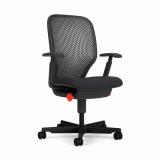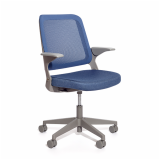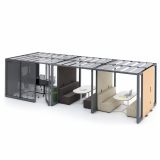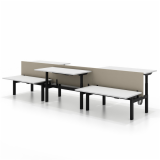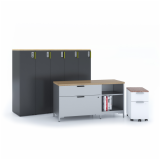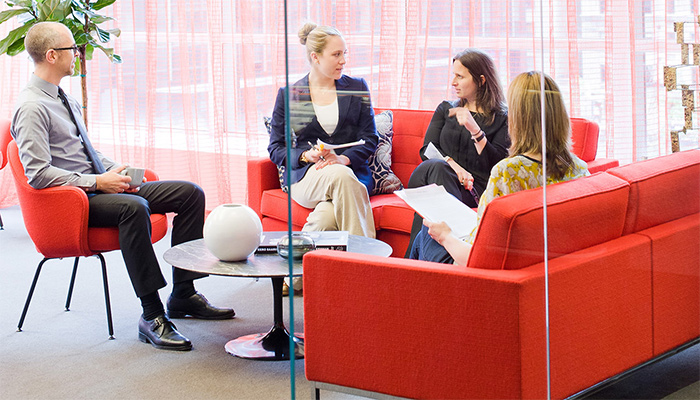
Good Planning and Preparation Go a Long Way
Securing approval for the new workplace strategy you are proposing goes beyond getting a time slot on the senior executive meeting agenda. Without a compelling business case, you may not get a second chance to be considered.
A recurring question is often echoed by members of workplace transformation teams. “Is the business case we’re developing compelling enough to gain approval for our new workplace strategy?” The question is indeed a valid one; in the typical organization, there is limited funding available for investment in improvement initiatives. Your group may be competing for budget approval against any number of other departments that are equally as confident as your team that their proposed initiative (new accounting software, advertising campaign, factory equipment upgrade, etc.) will benefit the enterprise. In reality, your team may only get one chance to plea your case and secure buy-in for the workplace change you are enthusiastically promoting.

Figure 2. Anticipate the reaction of senior leadership to your workplace strategy. In making your case, appeal to executives’ emotional needs as well as their commitment to serve the organization.

Figure 1. The workplace change you are embarking upon creates an opportunity to drive other changes necessary for the organization’s success in the future.
From the book Innovations in Office Design: The Critical Influence Approach to Effective Work Environments
The goal of this paper is to look beyond the many benefits of a new workplace strategy and reveal insights learned from organizations that have successfully gained approval for significant changes to the work environment. We look to provide the ammunition necessary to increase your level of confidence in upwardly selling a compelling business case to senior leadership.
Dispelling the Myths
Workplace transformation teams that have been successful in securing approval for making significant changes to the work environment have learned that two commonly-held beliefs must be abandoned.
Myth #1: It’s best to wait until other organizational changes have subsided.
Lessons Learned: While the expression “timing is everything” holds some truth, realistically, you would be hard pressed to find a point in time when your organization was not experiencing change of some sort.
If what you are proposing can be linked to broader, corporate initiatives (e.g. cost repositioning, reduction in real estate portfolio, etc.), by all means, perform an appropriate level of due diligence, document your findings in a comprehensive business case, and quickly request an audience with members of the C-suite to demonstrate how the workplace strategy can support the overall goals of the enterprise.
However, if prematurely scheduling your pitch for workplace change to senior leaders without sufficient quantitative and qualitative justification, then you’ll likely lack the ammunition needed for approval. If presenting the case too late, then you may gain approval, but your team may need to proceed with constraints that necessitate compromises to the integrity of the workplace strategy itself.
Myth #2: Hitching the business case for a new workplace strategy to the initiatives of other functional groups will slow down the decision-making process.
Lessons Learned: Successful workplace transformation teams have often found the opposite to be true. By combining efforts with the right internal partner—where the workplace change may complement another department’s goals—approval can come more quickly after presenting a business case that serves broader corporate objectives (Figure 1).
For example, a meeting with key individuals within the organization’s human resources group may uncover a synergy worth exploring. Chances are, your business case may reinforce one they are developing, and vice versa, thus increasing the likelihood of approval by senior leadership. A planned alternative workplace initiative that increases the ratio of worker to workspace can be made possible with executive buy-in for a structured, flex work program. The workplace strategy which fosters greater mobility can benefit human resources by expanding the talent pool, enabling the company to hire the best individual, regardless of geographic location.
Taking a Preemptive Stance on Resistance
The driver for a new workplace strategy often begins as a corporate edict to significantly reduce costs, revealing an opportunity to dramatically change how space is allocated. Signs that the workforce may be ready for new work styles may surface in the results of focus groups or a workplace satisfaction survey. Further, lease expiration dates may indicate there is sufficient time to investigate and test new ways of working. Realistically, you acknowledge that there will indeed be resistance to the new workplace strategy being proposed; however, your analysis predicts that the benefits to the organization will far outweigh the time necessary to overcome the resistance.
A step proven effective in strengthening the business case for a new workplace strategy is anticipating the case that various stakeholders in your organization may have against it and developing a plan for the enterprise to overcome the concerns of these key groups: 1) organizational leaders, 2) managers and supervisors, 3) HR professionals, 4) IT professionals, 5) facilities professionals, 6) individual contributors eligible to enroll in new ways of working, and 7) individual contributors not eligible for enrollment.
Anticipating the Case Against Your Workplace Strategy
For example, you and other members of the workplace transformation team may want to propose to senior leadership a workplace strategy that includes an open, shared-space work environment with a variety of unassigned workspace settings from which employees can select the appropriate space for the activity they will be performing. The strategy may also include a formal mobility program supported by written flex work policies and protocols to guide employees in determining where, when and how they can most effectively conduct their work.
Anticipate, in advance, where the resistance will occur. For each stakeholder group, list—in their language—the reaction you believe you will hear (Figure 3). Are there unspoken concerns of each group that may derail your workplace strategy, once approved? Advanced planning can help mitigate risks.
Mitigating the Risks
Consider your audience and their appetite for risk. Members of the C-suite would probably consider a pilot of the new workplace strategy less risky than rolling out the concept to a broad group without a chance to fine tune the design solution. Articulate how a feedback loop will be incorporated into the process to capture the ideas of those who will occupy the pilot space.
Think of how the workplace strategy being considered will result in a need for changed behaviors. Include in the business case how the organization can prepare the workforce for the change (e.g. communications, training, engagement initiatives). Changes to the physical work environment—large or small —will affect the people who work in the space. The importance of partnering with the Human Resources Department to create a plan for transitioning employees to new ways of working cannot be over emphasized. That transition plan becomes one of the methods to mitigate the risks of the changes being proposed.
Requesting Action
Lastly, ensure your business case ends with a specific request for what you need to support the success of your proposed workplace strategy. Surprisingly, many business cases that failed to receive approval did not clearly articulate a specific dollar amount being sought, internal support staff requested, external expertise required or mention of the level of involvement needed by the senior leaders themselves.
Armed and Ready to Sell Your Workplace Strategy
A compelling business case for workplace change goes beyond providing a list of the many benefits of the workplace strategy you are recommending.
Lessons learned from workplace transformation teams that have been successful in gaining buy-in from senior leadership for significant changes to the work environment may be applicable to your own efforts. The appropriate timing of the presentation of your business case, as well as how you articulate the ability of the workplace strategy to support other business objectives may, in fact, accelerate approval for the new workplace strategy.
In effectively presenting the business case for workplace change, you’ll speak the language of senior executives, capture the attention of the C-suite and create a sense of urgency to take action. The most compelling business cases also engage senior leadership in the transformation process and hold individuals accountable throughout the enterprise— including the leaders themselves—for new behaviors in the evolving work environment.
Download "Selling Upward" to Read the Full Paper
About the Author
Diane Stegmeier is Founder and CEO of Stegmeier Consulting Group, a globallyrecognized leader in workplace change management.
Stegmeier is best known for her extensive research on resistance to workplace change and her discovery of the 15 Critical Influences™ impacting behavior in the workplace. She is author of Innovations in Office Design: The Critical Influence Approach to Effective Work Environments, which was ranked the top workplace strategy book by Amazon readers. Stegmeier is the recipient of the International Facility Management Association’s (IFMA) Award of Excellence, Distinguished Author for a Book.
Suggested Reading and Resources
Buhl, Larry, Can Telecommuting Hurt Your Career?, Career Builder, MSN Careers, April 24, 2013,
http://www.careerbuilder.com/Article/CB-3310-Workplace-Issues-Can-telecommuting-hurt-your-career/
Debelak, Don, Perfect Phrases for Presenting Business Strategies, ISBN 978-0-07-163996-5, McGraw Hill Companies, Inc., New York, NY 2010
Fister Gale, Sarah, “Some Companies Replace Cubicles with Flex Spaces,” Workforce Magazine, May 30, 2013,
www.workforce.com
Gurchiek, Kathy, “Senior Leader Accountability: Critical to Successful Change,” HR News: Society for Human Resource Management, June 2009.
Ignoring Alternative Workplace Solutions: The Fast Track to 2nd Place – IDCEC Continuing Education Unit –
http://www.stegmeierconsulting.com/ceu.
Löfvenhamn, Clara, “Bosses with Private Offices an Endangered Species,” Sweden’s Chef (Boss) Magazine, September 30, 2013,
http://chef.se/chef-med-eget-rum-en-utrotningshotad-art/.
Madell, Robin, “Flex Execs: How to Get Your Teammates on Board with Your Telecommuting,” The Glass Hammer, October 1, 2012,
http://www.theglasshammer.com/news/2012/10/01/flex-execshow-to-get-your-teammates-on-board-with-your-telecommuting/.
Morton, Jennie, “The Next Generation of Open Offices,” Buildings Magazine, April 30, 2013.
Nilsson, Ola, “Office to Become Social Magnet,” Sydsvenskan Newspaper, Malmö, Sweden, September 30, 2013,
http://www.sydsvenskan.se/ekonomi/kontor-ska-bli-sociala-magneter/.
O’Neill, Michael, Managing Workplace Change: A People-Based Perspective. Knoll White Paper, Knoll, Inc., New York, 2012.
O’Reilly, Charles, “First Selling the Idea to Senior Leaders Helps Organizations Realize Change,” Stanford Graduate School of Business, July 1, 2010,
http://www.gsb.stanford.edu/news/research/oreilly_change_7_10.html.
Palombo Weiss, Ruth, “Hot Topic: Flex-work,” American Society for Training & Development – LX-Briefing, November, 2012,
http://www.astd.org/Publications/Newsletters/LX-Briefing/LXBArchives/2012/11/Hot-Topic-Flexwork.
Stegmeier, Diane, Communicating Workplace Change: Starting with the Basics. Knoll White Paper, Knoll, Inc., New York, 2013.
Stegmeier, Diane, Innovations in Office Design: The Critical Influence Approach to Effective Work Environments, ISBN 978-0-471-73041-5, John Wiley & Sons, Inc., Hoboken, NJ, 2008.
Stegmeier, Diane, “The Business Case for Web Commuting,” White Paper, Citrix Online, Goleta, CA, 2010.
Stegmeier, Diane, “The Evolution of Change Management: Changing the Way Organizations Manage Workplace Change,” Ecophon Executive Briefing, London, U.K., September 26, 2013,
http://www.stegmeierconsulting.com/blog/ecophon-executive-briefing-the-evolution-of-changemanagement/.
Stegmeier, Diane, “The Evolution of Change Management,” WorkTech 2013, New York, NY, May 16, 2013,
http://www.stegmeierconsulting.com/blog/worktech-the-evolution-of-change-management/.
Stegmeier, Diane, “The Facility Manager’s Guide to Launching an Alternative Workspace Initiative,” White Paper, PeopleCube, Boston, MA, 2010.
Stegmeier, Diane, “The Future Office Workspace,” Ecophon Round Table, Malmö, Sweden, September 25, 2013,
http://www.stegmeierconsulting.com/blog/the-future-office-workspace-roundtablediscussion-fall-2013/.
Szaniszlo, Marie, “Work Space … the Final Frontier,” Boston Herald, Boston, MA, April 22, 2012,
http://www.bostonherald.com/news/regional/view.bg?articleid=1061126188.
Thornton, Lisa, “When Looks Matter: What a company’s physical space and design reveals about its corporate culture and its appeal to employees and clients,” Change Magazine, Volume 3 Issue 4, August 2013.




















